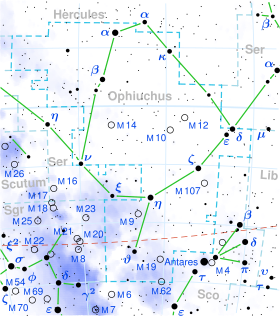Tau Ophiuchi
Appearance
(Redirected from Τ Ophiuchi)
| Observation data Epoch J2000 Equinox J2000 | |
|---|---|
| Constellation | Ophiuchus |
| Right ascension | 18h 03m 04.91992s[1] |
| Declination | −8° 10′ 49.2586″[1] |
| Apparent magnitude (V) | 5.24 (A) / 5.94 (B) [2] |
| Characteristics | |
| Spectral type | F2V(A) / F5V (B) [2] |
| U−B color index | +0.05 (A)[3] |
| B−V color index | +0.38 (A)[3] |
| Astrometry | |
| Radial velocity (Rv) | -38.39[4] km/s |
| Proper motion (μ) | RA: +15.78[1] mas/yr Dec.: -37.79[1] mas/yr |
| Parallax (π) | 19.48 ± 0.66 mas[1] |
| Distance | 167 ± 6 ly (51 ± 2 pc) |
| Details | |
| Mass | 1.54 (A) / 1.29 (B)[5] M☉ |
| Surface gravity (log g) | 4.18 (A)[6] cgs |
| Temperature | 6,813 (A)[6] K |
| Other designations | |
| Database references | |
| SIMBAD | data |
Tau Ophiuchi (τ Oph) is a multiple star in the constellation Ophiuchus, approximately 167 light years away based on parallax.[1] Its two main components are two yellow-white main sequence stars, A, of magnitude 5.24 and class F2V, and B, of magnitude 5.94 and class F5V,[2] orbiting each other with a period of 257 years and eccentricity around 0.77.[7] A is reported as a spectroscopic binary with a smaller star of 0.29 solar masses orbiting it every 186 days.[5] An additional component, C, has a separation of 100.8" and magnitude 11.28.[8]
References
[edit]- ^ a b c d e f Van Leeuwen, F. (2007). "Validation of the new Hipparcos reduction". Astronomy and Astrophysics. 474 (2): 653–664. arXiv:0708.1752. Bibcode:2007A&A...474..653V. doi:10.1051/0004-6361:20078357. S2CID 18759600. Vizier catalog entry
- ^ a b c Hoffleit, D.; Warren, W. H. (1995). "VizieR Online Data Catalog: Bright Star Catalogue, 5th Revised Ed. (Hoffleit+, 1991)". VizieR On-line Data Catalog: V/50. Originally Published in: 1964BS....C......0H. 5050. Bibcode:1995yCat.5050....0H.
- ^ a b Mallama, A. (2014). "Sloan Magnitudes for the Brightest Stars". The Journal of the American Association of Variable Star Observers. 42 (2): 443. Bibcode:2014JAVSO..42..443M.
- ^ Pourbaix, D.; Tokovinin, A. A.; Batten, A. H.; Fekel, F. C.; Hartkopf, W. I.; Levato, H.; Morrell, N. I.; Torres, G.; Udry, S. (2004). "SB9: The ninth catalogue of spectroscopic binary orbits". Astronomy and Astrophysics. 424 (2): 727–732. arXiv:astro-ph/0406573. Bibcode:2004A&A...424..727P. doi:10.1051/0004-6361:20041213. S2CID 119387088.
- ^ a b Tokovinin, A. (2008). "Comparative statistics and origin of triple and quadruple stars". Monthly Notices of the Royal Astronomical Society. 389 (2): 925–938. arXiv:0806.3263. Bibcode:2008MNRAS.389..925T. doi:10.1111/j.1365-2966.2008.13613.x. S2CID 16452670.
- ^ a b David, Trevor J.; Hillenbrand, Lynne A. (2015). "The Ages of Early-Type Stars: Strömgren Photometric Methods Calibrated, Validated, Tested, and Applied to Hosts and Prospective Hosts of Directly Imaged Exoplanets". The Astrophysical Journal. 804 (2): 146. arXiv:1501.03154. Bibcode:2015ApJ...804..146D. doi:10.1088/0004-637X/804/2/146. S2CID 33401607. Vizier catalog entry
- ^ Malkov, O. Yu.; Tamazian, V. S.; Docobo, J. A.; Chulkov, D. A. (2012). "Dynamical masses of a selected sample of orbital binaries". Astronomy & Astrophysics. 546: A69. Bibcode:2012A&A...546A..69M. doi:10.1051/0004-6361/201219774. Vizier catalog entry
- ^ Mason, Brian D.; Wycoff, Gary L.; Hartkopf, William I.; Douglass, Geoffrey G.; Worley, Charles E. (2001). "The 2001 US Naval Observatory Double Star CD-ROM. I. The Washington Double Star Catalog". The Astronomical Journal. 122 (6): 3466. Bibcode:2001AJ....122.3466M. doi:10.1086/323920. Vizier catalog entry

